From Albert Beale
Recorded by Peter Kennedy and Maud Karpeles, Kenardington, 14th January 1954
BBC recording 21157
From Albert Beale
Recorded by Peter Kennedy and Maud Karpeles, Kenardington, 14th January 1954
BBC recording 21157
From Albert Beale
Recorded by Peter Kennedy and Maud Karpeles, Kenardington, 14th January 1954
BBC recording 21157
Beef when you’re hungry
Beer when you’re dry
Feather bed to lay on
And heaven when you die
If you don’t like that you can have:
Bread when you’re hungry
Water when you’re dry
Chaff bed to lay on
And hell when you die
From Albert Beale
Recorded by Peter Kennedy and Maud Karpeles, Kenardington, 14th January 1954
BBC recording 21156
From Albert Beale
Recorded by Peter Kennedy and Maud Karpeles, Kenardington, 14th January 1954
BBC recording 21156
From Albert Beale
Recorded by Peter Kennedy and Maud Karpeles, Kenardington, 14th January 1954
BBC recording 21156
Roud 483, Child 105
From Albert Beale
Recorded by Peter Kennedy and Maud Karpeles, Kenardington, 14th January 1954
BBC recording 21157
This was presumably one of the songs which the Beale family would sing when they went out carolling. Cecil Sharp had previously noted the carol from Albert’s father James Beale, and from his sister Alice Harden.
From Albert Beale
Recorded by Peter Kennedy and Maud Karpeles, Kenardington, 14th January 1954
BBC recording 21156
‘Fol-the-rol-lol’ was first published in 1902. Credited to Fred W. Leigh and Fred Murray, it was sung by George Lashwood (1863 – 1942), a popular English singer and comedian of the Edwardian era. For more information, see https://folksongandmusichall.com/index.php/fol-the-rol-lol/
In her report on her October 1953 folk song expedition to Kent, Maud Karpeles wrote that she had recorded a version of ‘John Barleycorn’ from “Dave Wicken”, at Smarden.1 The fate of that recording is, sadly unknown – it is not listed in either the Vaughan Williams Memorial Library catalogue, or the Roud Index.
Dave Wickens had been born at Boughton Malherbe on St David’s Day, 1st March 1898. At the time of the 1901 census his father James was working for his father, William Wickens, who farmed at Park House Farm, Boughton Malherbe. William was originally from Ulcombe. He had been an agricultural labourer, but by 1891 had progressed to farm bailiff, and farmer by 1901. David’s mother was Annie Maria, née Martin, who came from Dover. She and James would ultimately have six children; David was the third eldest, and the second eldest son. By the next census in 1911, James Wickens was farming Park House Farm, and by 1921 Dave was “Assisting Father In General Farm Work”.
Between these dates, however, Dave had served in the Royal Navy. His service appears to run from 6th November 1916 to 18th March 1919. When enlisting, his occupation was given as agricultural labourer. He was 5 feet 3½ inches tall, with dark hair, hazel eyes, and a fair complexion. His service began at HMS Pembroke II (Eastchurch, Isle of Sheppey) and included periods at Gibraltar, Woolwich and Greenwich, and on board HMS Dido, HMS Columbine, HMS Hecla and HMS Prince George.
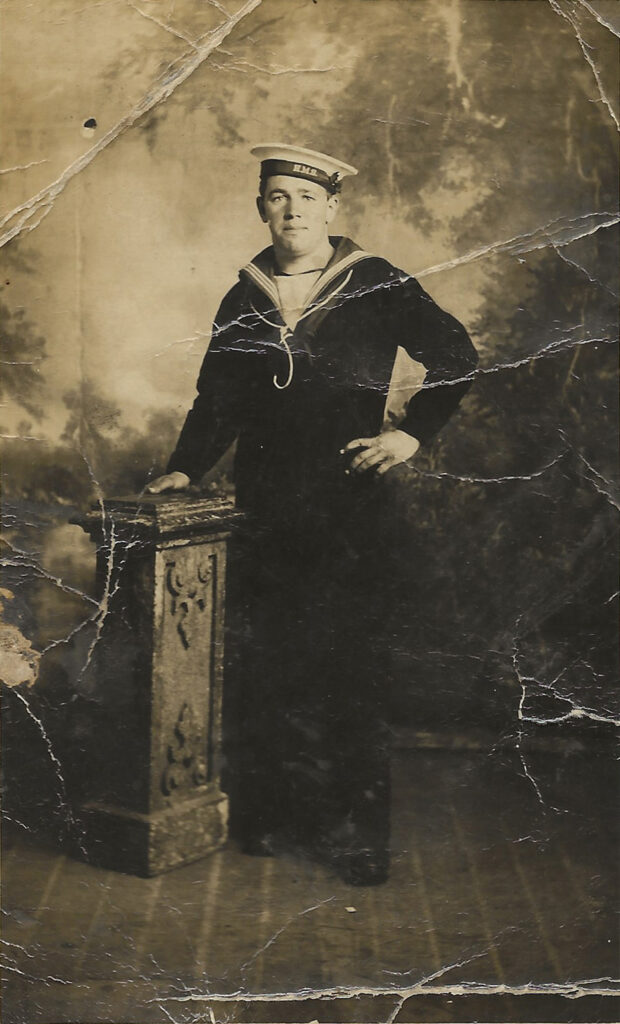
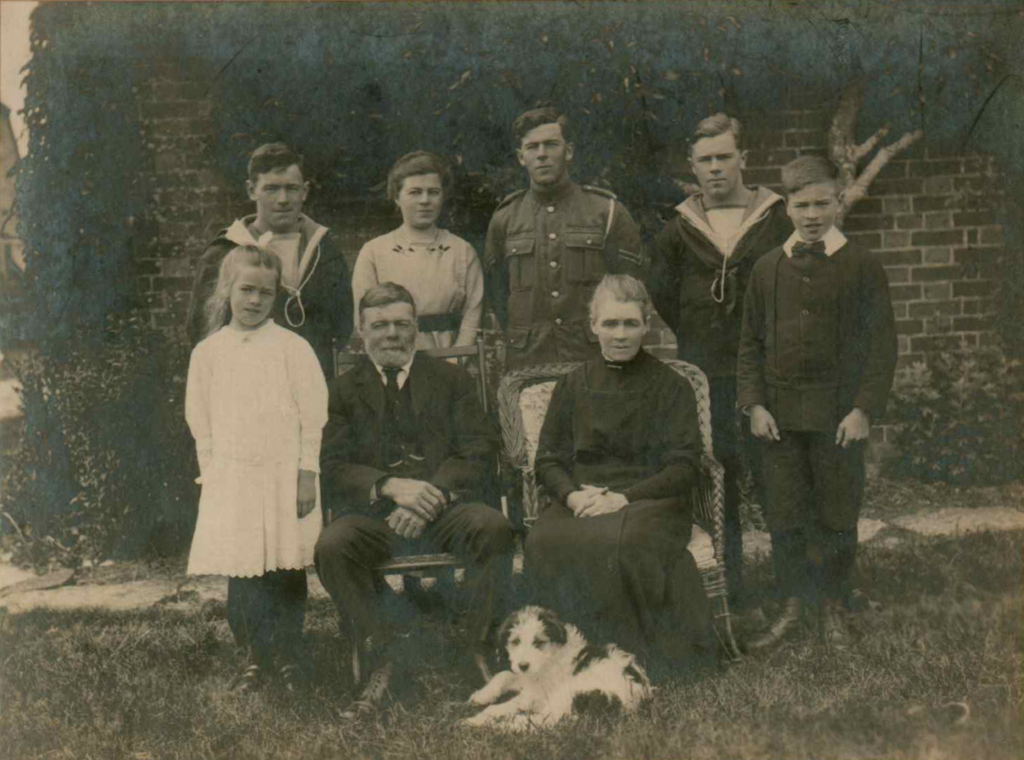
Dave married Ethel Pack in the final quarter of 1924, and the 1939 Register shows them living at Haffenden Farm, Tenterden – roughly halfway between St Michael’s and Biddenden. Dave’s occupation was given as “Farmer Stock Breeder Hw” (i.e. Heavy Worker). His granddaughter Gill Bromley, who has fond memories of visiting her grandfather at Haffenden as a child in the 1960s, writes “Dave was married to Ethel Pack (another big local family) and they moved from a farmworkers cottage at South Park, Egerton to Haffenden Farm before the War in 1938 or 39. They rented it until Dave eventually bought it”.
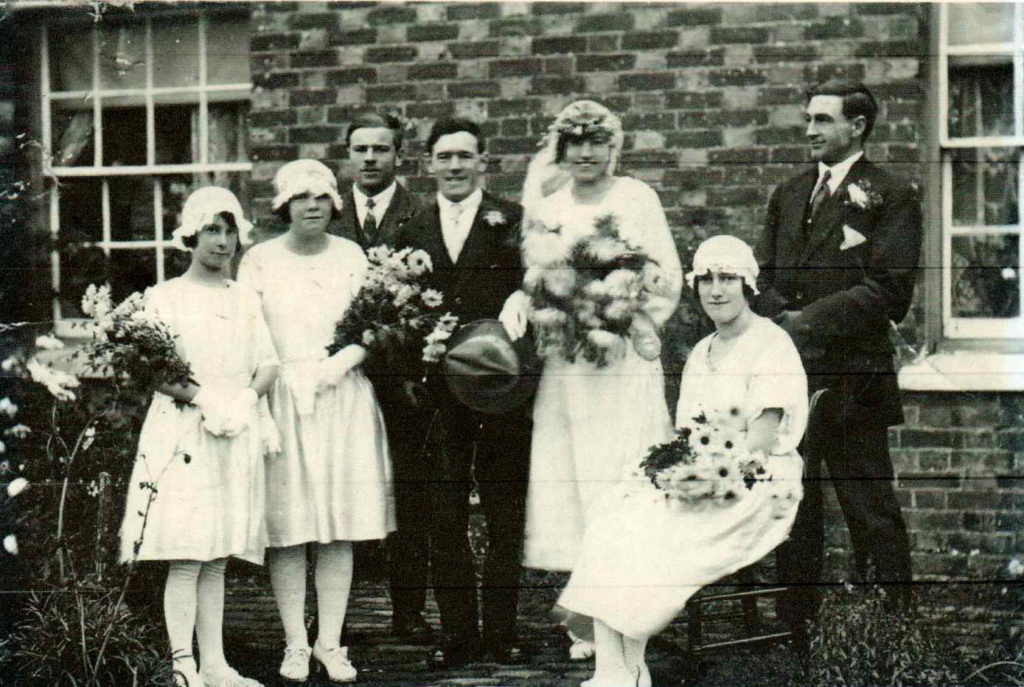
Dave and Ethel had five daughters, all apparently named after characters in folk songs. One of his surviving daughters recalls him “singing at home, after tea. There was one song he had to stop singing as it made her cry, because it was sad – The Faithful Sailor Boy”. Also “John Barleycorn, which she’d found a bit scary as a child (involved “cutting him down at the knees”). She also remembered him singing carols at Christmas at his mother’s request. But she couldn’t remember him singing publicly other than in the church choir”. There’s no recollection in the family of him singing songs in other contexts, although he “did go to the Flying Horse [Smarden] on Saturdays, so maybe there was singing there?”2 It seems likely that he had some kind of local reputation as a singer, or how would Maud Karpeles have encountered him in 1953?
Dave Wickens died on 8th October 1970.

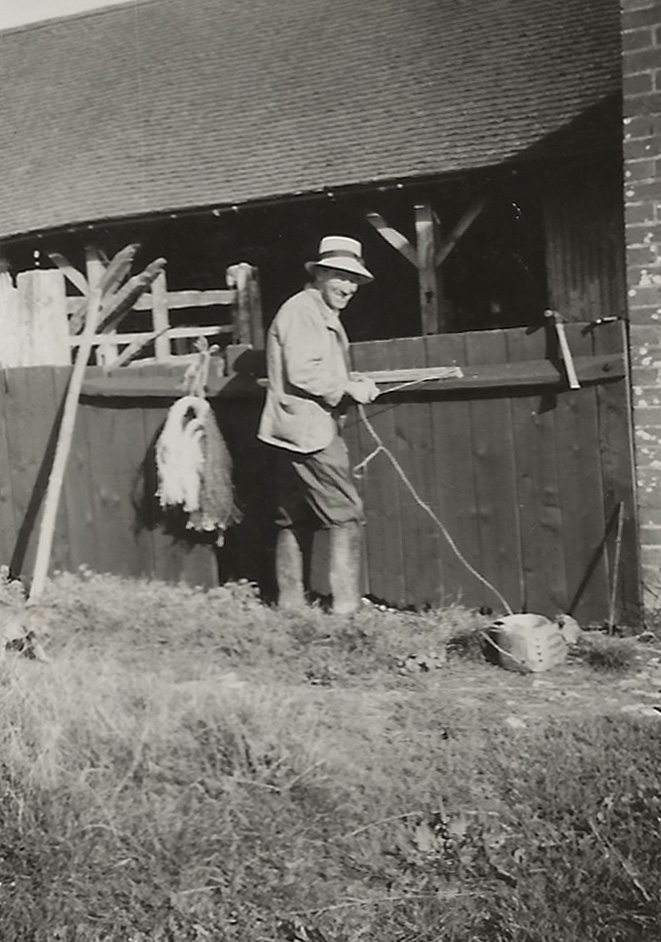

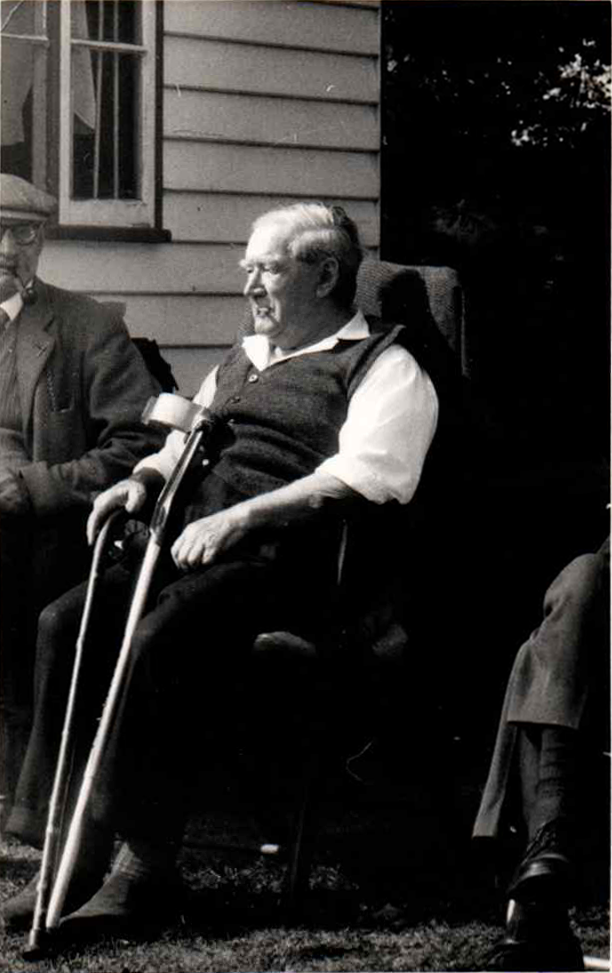
I am indebted to Gill Bromley (née Batt) for passing on her own recollections, and those of other descendants of Dave Wickens, and for providing these photographs.
The son of Charlotte and James Beale, and brother of Alice Harden, Albert was born on 18th May 1875 and baptised at St Mary the Virgin, Orlestone on 18th July. The 1881 census found him living in Hamstreet with his maternal grandparents, Charles and Phoeby Hall. Ten years later, aged 16, he was living with his parents, with his occupation described as “Dealer”.
Interviewed in 19831, Albert’s son Charles said that his father was very bright, especially at Maths, and his teacher at the Orlestone Board School in Hamstreet wanted him to become a schoolmaster. However Albert’s family couldn’t afford to keep him at school, so he left school at 14, and spent the rest of his life doing farmwork – although he never really settled at anything. He’d do a bit of work, then do nothing for a while – one farmer said that when Bert was working he’d give him two men’s work just to keep him occupied. Albert himself admitted in 1954 “I been all over the shop, let me tell you the straight truth. I was a rolling stone”2. Asked what jobs he had done, he mentioned milking cows, and what sounds like “chicken packing”. Charles Beale said that his father used to earn a lot of money “chicken picking” – he would walk 7 days a week from Kenardington to Woodchurch (about 2½ miles) when he was doing that.
In the same interview, Albert’s wife said that he had “been a soldier three or four times”, which seems to be about right. He signed up for the 3rd Battalion of The Buffs – the Royal East Kent Regiment – on 26th October 1891. He gave his age as 18, but was in fact only 16 at the time (at the age of 80 he claimed “well I weren’t only a youngster when I went in the Army, nearly fourteen and a half years old”, but he was exaggerating just how young he had been). He was 5 feet 7 1/2 inches tall, weighed 125 pounds, and gave his religious denomination as Wesleyan. His stint in the army did not last long – he purchased his discharge (or more likely, perhaps, his parents did) on 29th October. However on 29th December 1898 he signed up again, this time with the Royal Artillery. His age was recorded – truthfully this time – as 22 years and 5 months. He was now 5 feet 9 inches tall, weighed 146 pounds, was put down as Church of England and, in the ‘Distinctive Marks’ section, a number of tattoos were recorded, as well as a scar over his seventh cervical vertebra. Again, he did not stay long with the regiment – he purchased his discharge for £10 on 10th January 1899.
By the time of the 1901 census he was back living with his parents, listed as “Ordinary agricultural labourer”. On 9th May 1906 he married Ellen Maria Kingsland at Minster in Thanet. Ellen was already the mother of two children, Percy and Florence – almost certainly illegitimate, as she does not appear to have married previously, and no father’s name was recorded on the baptism certificate for either child.
In 1911, Albert was working as “Farm labourer general” at Martin, East Langdon, near Dover. As well as his two step-children, he and Ellen now had a child of their own, Phyllis Bertha Kingsland Beale, who was baptised at St Matthew’s, Warehorne, on 27th March 1910.
The First World War took Albert back into the Army – he enlisted with the Special Reserve of The Buffs, “willing to be enlisted for General Service”, on 11th January 1915. He gave his occupation as “Labourer”, and his address as The Leacon, Warehorne, Kent. Posted on 19th January, he was discharged on 26th March the same year – “not likely to become an efficient soldier”. One assumes that, as the war dragged on, the Army became less fussy about its recruits, for from 2nd November 1917 Albert was back in uniform again, with the Bedfordshire Regiment. The digitised army service records for Albert Beale from this period are not easy to read, but it appears that he may have seen some action on the Western front, before being transferred in June 1918 to the 11th Battalion of the Bedfordshire Regiment – this was a Territorial Battalion, based at Pakefield near Lowestoft in Suffolk, involved in coastal defence. He was demobbed on 31st January 1919.
These later service records give his address simply as The Bungalow, Warehorne. By 1921 the family was living at Bridge Farm Cottage, Warehorne. Albert was back working as a farm labourer, for Mr E. R. Todd, and the family had grown: Albert’s step-children had moved out, but he and Ellen now had two daughters and three sons. Local directories from 1922 onwards list him at Tinton Farm Cottage, Warehorne, while the 1939 Register shows the family as living at Tinton Bungalow, Warehorne. Albert is listed as unemployed, rather than retired; two of his sons, Robert and Charles are working as cowmen; the third, Reggie, is a farm labourer.
Maud Karpeles visited Albert Beale at some point between October 12th and 17th 1953, when she came to Kent on a song collecting expedition. She subsequently returned with her nephew Peter Kennedy, and they recorded Albert, then aged 80, at Kenardington on 14th January 1954. One of Kennedy’s strategies for finding singers was to look for the descendants of singers from whom Cecil Sharp had collected songs earlier in the century, and his interest in Albert Beale was sparked by the carol ‘The Moon shines bright’, which Sharp had noted both from his father James Beale, and his sister Alice Harden.
Kennedy’s recordings include six songs and a toast, plus talk about his life and where he learned the songs. Asked by Kennedy how he came by his songs, he replied “I used to buy ‘em like… My mother once… I got half a bushel basket full of ‘em, she burnt ‘em”. Kennedy followed up with “But where did you buy them?”, to which the answer was “All over the place. Wherever. Well, you know, when I used to sing, you see…”, while his wife added “You used to buy those penny sheets of songs, out of a newspaper shop, couldn’t you?” Some – such as ‘The Frog and the Mouse’ – were learned at school:
Why it’s a… youngsters, when we was at school, we had it knocked into us, these old songs, with the schoolmaster and that. We didn’t dare say we wouldn’t learn them. Well we had it, or we had a good hiding. That’s how we got ’em…
And clearly some must have been known by several members of the family – perhaps all of the family.
My mother used to lead the choir in Hamstreet Chapel. She used to hang on, you know. You know, now, they stop don’t it when it gets to go from one line to another. She used to turn it. Right round, keep going. Like that. She didn’t stop at all. But by Gor’ she could sing. At the end of a line you used to stop, she only… well she hung on you see, used to go [sharp intake of breath]… but oh, she was high pitched. Yes. Yes.
He’d also go out carolling, “all round here”, with the rest of the family.
Maud Karpeles: How many of you used to go round together?
Albert Beale: All our family.
MK: The whole family?
AB: Yes. We all used to be in the choir at once, ten of us at once, my mother used to sit down in church and lead us…
His wife Ellen pointed out “Ain’t never been [carolling] since we’ve been married… We’ve been married a long time” (48 years at the time of the recording).
Kennedy asks “And your father was a singer too?” to which Albert replies “Yes, yes. So was my brother, he could sing best when he was half drunk, couldn’t he? Oh, he could sing”. Based on information obtained from Charles Beale in 1983, he may have been referring to his younger brother James.
Charles added that his father used to sing mainly at home and family get-togethers, but not often in public. He sometimes played squeezebox (probably the anglo-concertina) when he sang. “He could sing”, Charles said; and his sister was a really good singer too, but “proper music”. It’s not clear if this comment referred to Alice Harden, or another of Bert’s sisters.
Albert knew a lot of songs, but only half a dozen were recorded, because – according to Charles Beale – although Peter Kennedy gave him one or two guineas, he didn’t keep his promise to pay him more when the songs were broadcast on the radio (presumably on Kennedy’s BBC radio programme As I roved out). Kennedy apparently paid several visits to the Beale home, but when he failed to keep his word regarding money, Bert wouldn’t have any more to do with him.
Albert Beale died in the final quarter of 1961.
Peter Kennedy’s report on his January 1954 trip also mentions
Maud Karpeles noted the titles at least of the following songs, when she visited Albert Beale in October 1953:3
None of these has an entry in the Roud Index.
The BBC recordings are held by the British Library, and are also available to listen to at the Vaughan Williams Memorial Library.
‘The Moon shines bright’ is available on You Never Heard so Sweet (Topic TSCD673, 2012).
‘The Bailiff’s Daughter of Islington’ was included on Classic Ballads of Britain and Ireland Volume 1 (Rounder Records 11661-1775-2, 2000).
A fragment of ‘The Frog and the Mouse’ was included on The Folk Songs of Britain Volume 10: Songs of Animals and Other Marvels (Topic 12T198, 1970).
Proudly powered by WordPress | Theme: Baskerville 2 by Anders Noren.